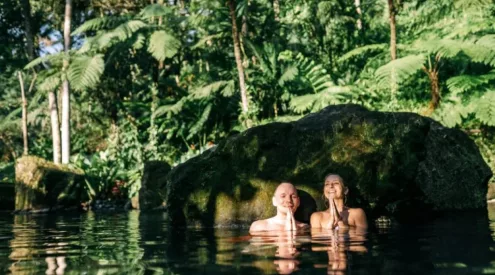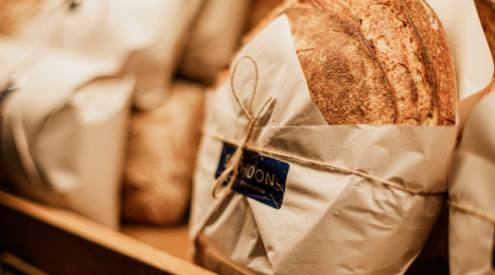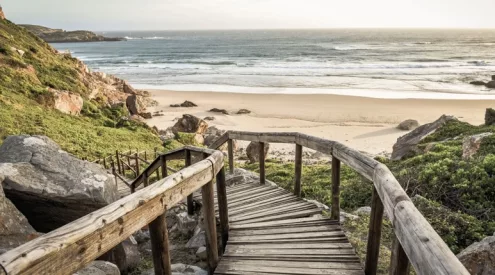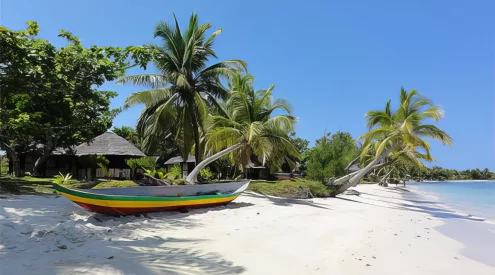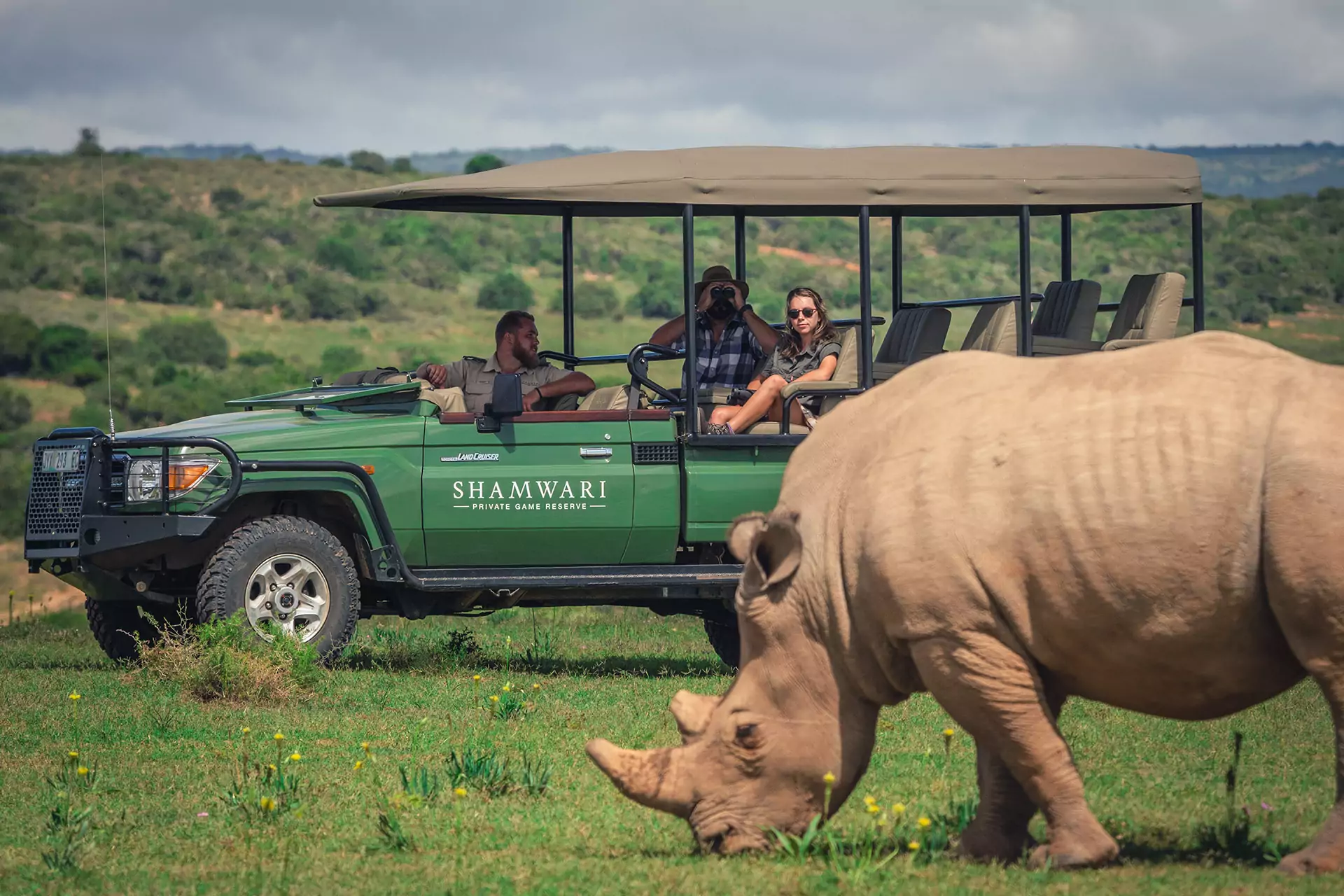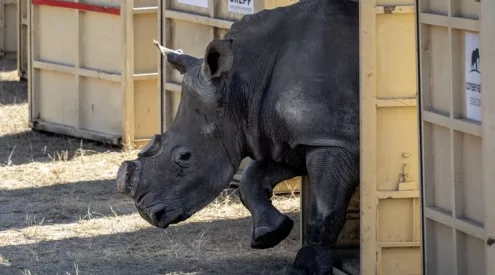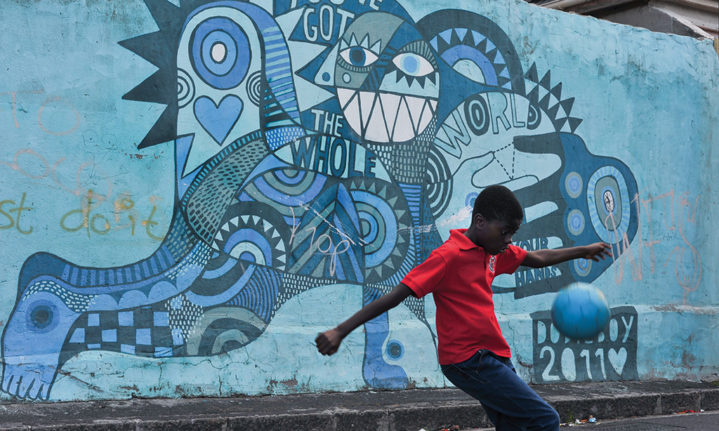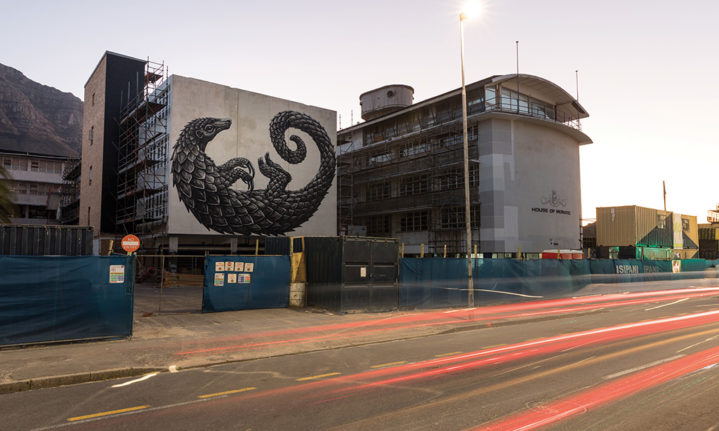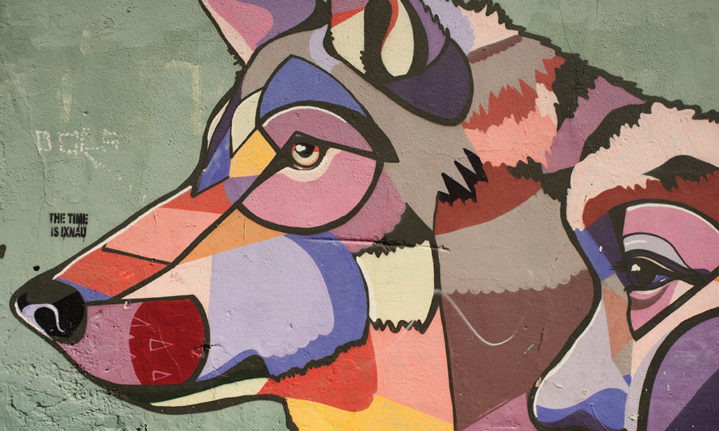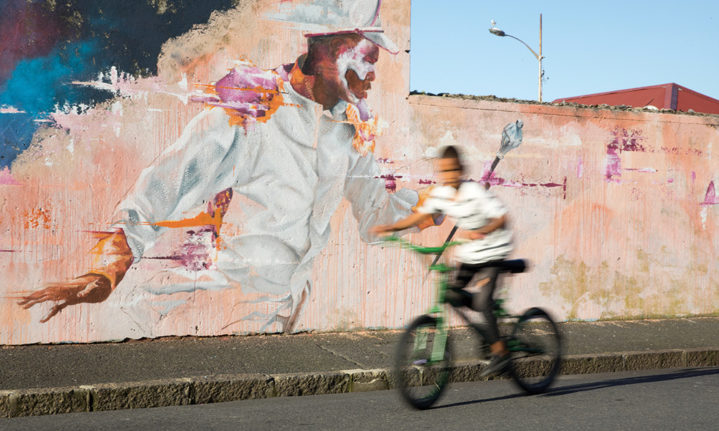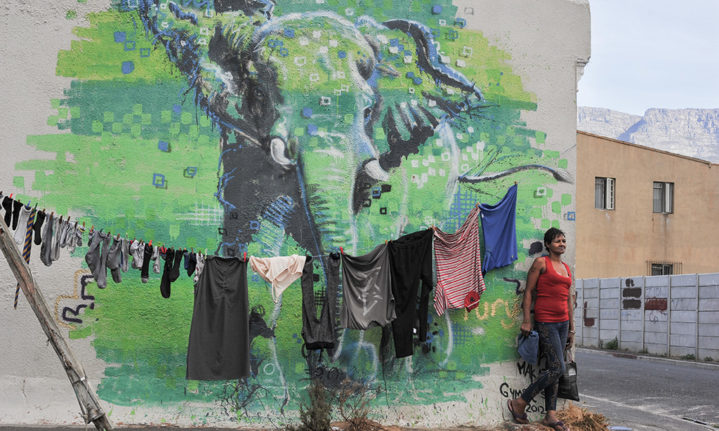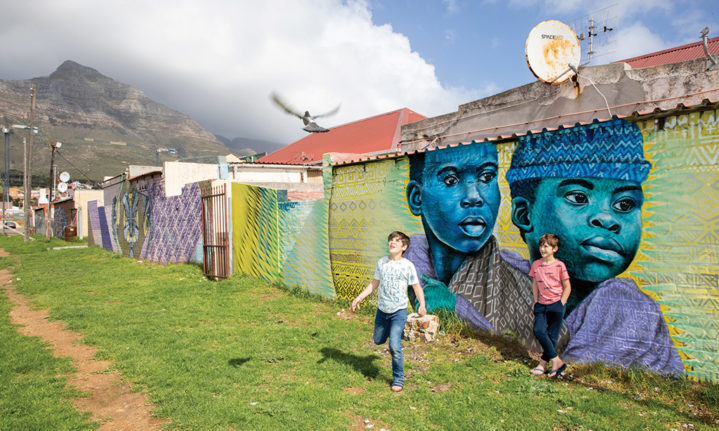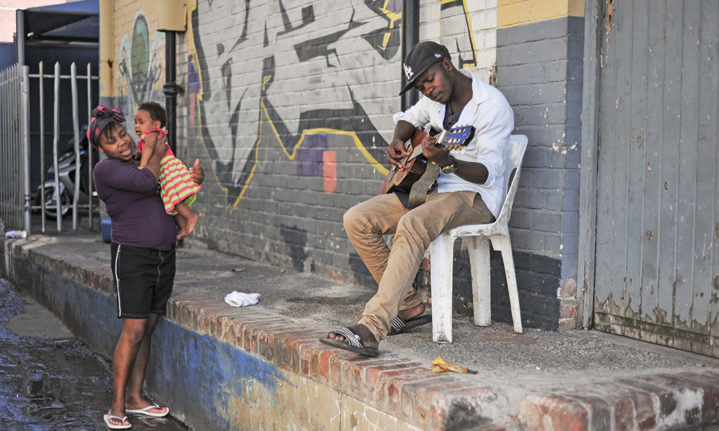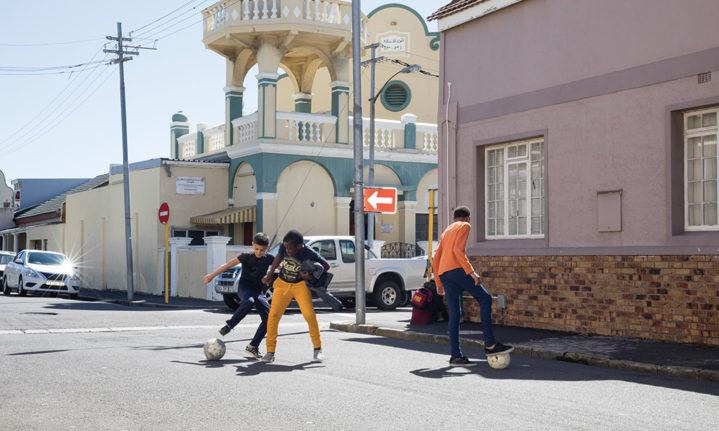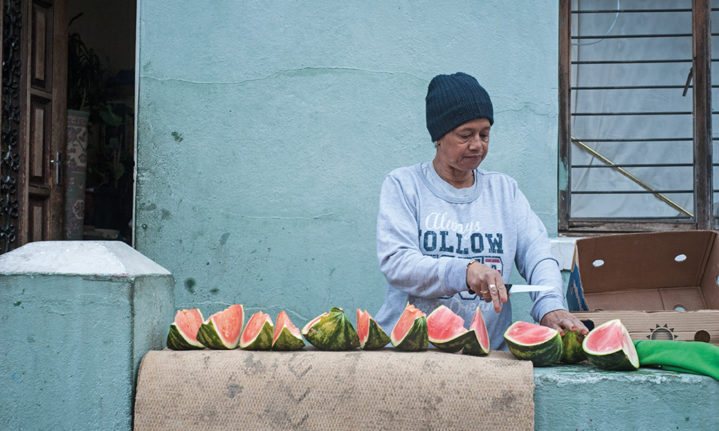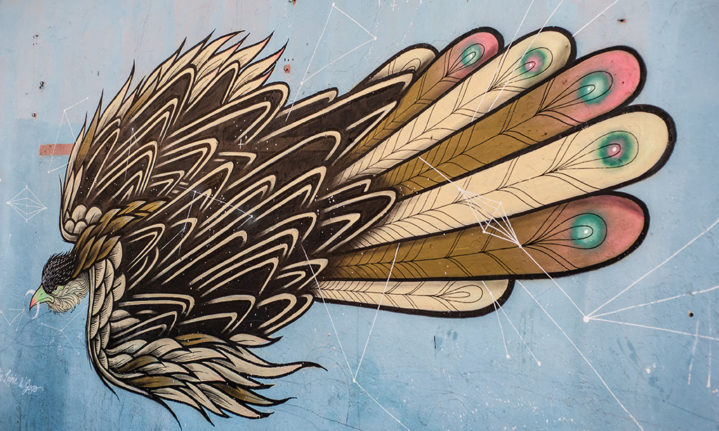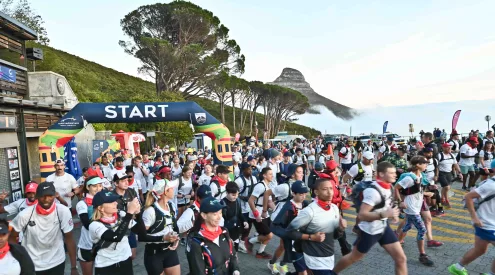Woodstock and Salt River in Cape Town are not only two of the most diverse neighbourhoods in South Africa, they’re also the most colourful, with street art from the zany to the sublime in this immense urban gallery.
Words & Photos Anton Crone

Rounding hospital bend into Cape Town, I always look out for a pair of jackal buzzards that patrol the sky above. Their domain is the slope where Rhodes has fallen, their prey the timorous beasts that scurry in the green skirts of Devil’s Peak. They perch on lamp posts along the highway which they sometimes cross to gaze down on the old graves of Groote Schuur Hospital, the urban melee and the sky rats beneath.

Street artists from all over the world have contributed to the International Public Art Festival, like Belgian artist ROA with his mural of a Pangolin on Victoria Road.
This is pigeon domain: concrete and brick near-indistinguishable from the cliffs on which their wild ancestors used to roost. Here, there is abundant food in the streets, in the bins, in scraps of bread. And they’re not alone, there’s other wildlife here, too, a habitat so diverse that every turn of a corner reveals something extraordinary, like the giant pangolin that dominates Main Road, flamingos parading on Swift Street, a lion pouncing on Sussex, a giraffe loitering on Frere and elephants crossing Essex, watched by a mountain gorilla not far up the street. There are leopards, rhinos, zebras and eagles. One street is even home to a wolf.
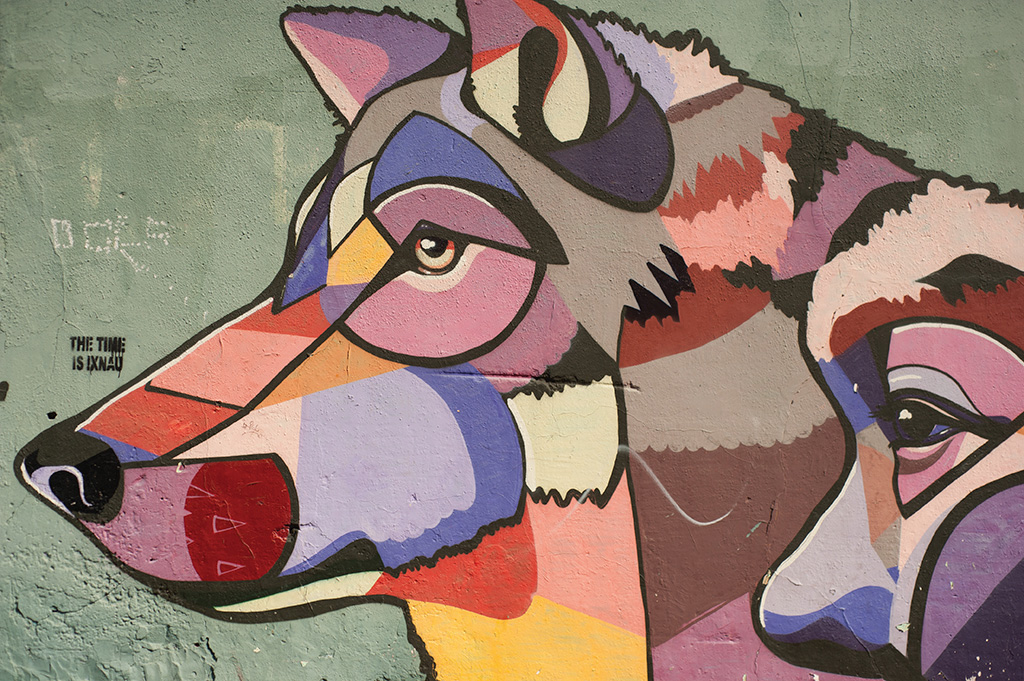
“Raised by Wolves” painted by Cape Town artist Nardstar.
This diversity extends to other inhabitants. I’ll walk a single block of Woodstock or Salt River and hear Arabic, French, Kikongo, Nyanja, Shona, Chichewa and a lyrical brand of Afrikaans. Greetings range from ‘as-salamu alaykum’, to ‘bonjour’, ‘yenge kiaku,’ ‘muli bwanji,’ ‘mhoro’ and ‘hoezit’!
When I’m not travelling abroad, I journey through these two neighborhoods to get my culture fix. It’s a microcosm of Africa, where poverty belies a new phase of gentrification and refugees bump shoulders with hipsters. When photographing Woodstock for an exhibition a couple of years back, I realised I spent most of my time on one single street: Gympie Street. It’s about 500 metres long, but it felt like it stretched all the way to Cairo because of all the nationalities I encountered. And it’s ever changing. Nellie and her granddaughter, Mbali, used to live at the end of Gympie in an abandoned café. On a winter evening, Nellie would invite me to warm myself by her steel drum fire. Now they’re gone; the building has been torn down to make way for a new development. On hold due to lockdown, gentrification has met a speed bump. But the pace will pick up and people will be bought out with unfair prices, evicted and relocated to even poorer areas like Blikkiesdorp, a temporary settlement in Delft, or the windswept Cape Flats, far from the already meager opportunities that Cape Town once provided.
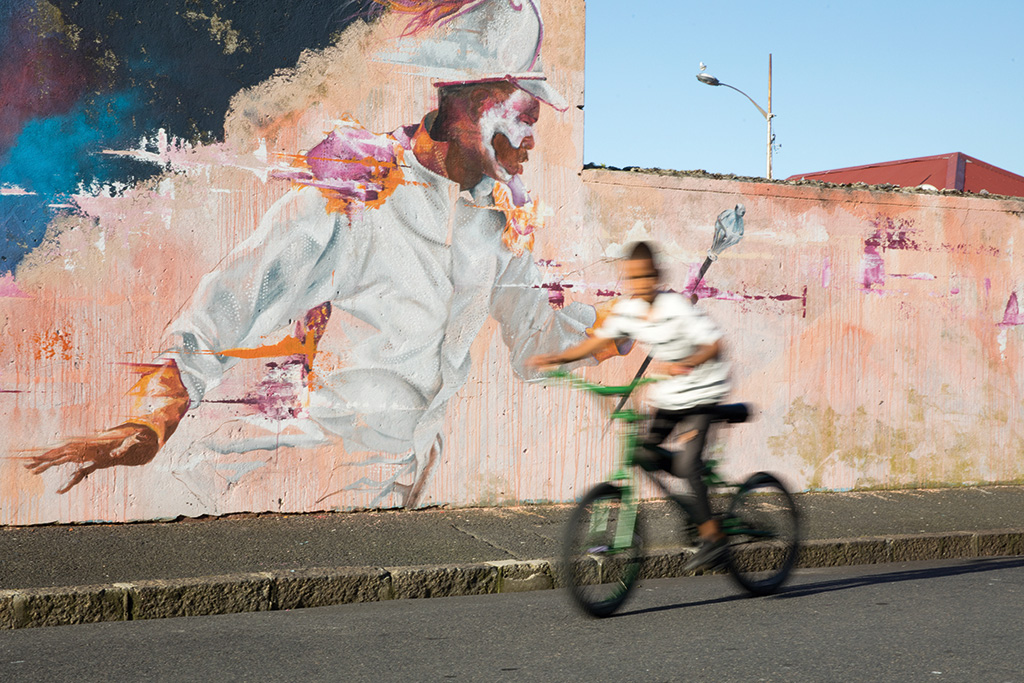
Part of the “Kaapse klopse” mural by page33, Zesta, Linus and Spear which stretches the entire length of Swift Street.
There’s a raucous echo of disreputable history here. In the 1970s, over 60 000 residents were forcibly removed from District Six, a multiracial, multi-religious community adjacent to Cape Town. Homes were bulldozed; communities were broken apart and stunned families were dumped on the Cape Flats. Some saw the writing on the wall and made it to Salt River and Woodstock before they were evicted. These neighborhoods are even more diverse, now joined by Africa’s diaspora, cafés and startup culture.
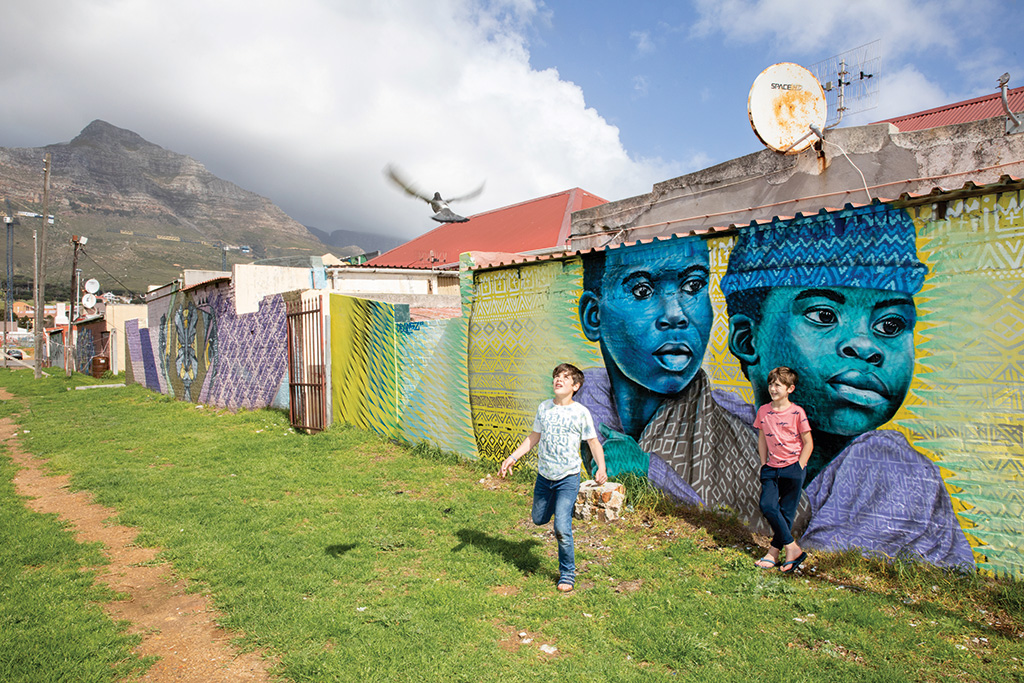
Shelly Street Sports Field is a perfect spot to start a street art tour.
In 2005, Indigo Properties refurbished the old biscuit mill adding fine-dining restaurants, trendy cafes and shops. It was one of the precursors of local gentrification and the influx of startups which many argue have benefited the community. The Neighbourgoods Market at the mill was launched around the same time. Every Saturday morning, hip Capetonians and tourists descend for the gourmet grub and artisanal fare. Sadly, it’s too expensive for working-class locals so there’s nothing really ‘neighbourgood’ about it, and the most interaction outsiders have is with a car guard or a beggar near the entrance.
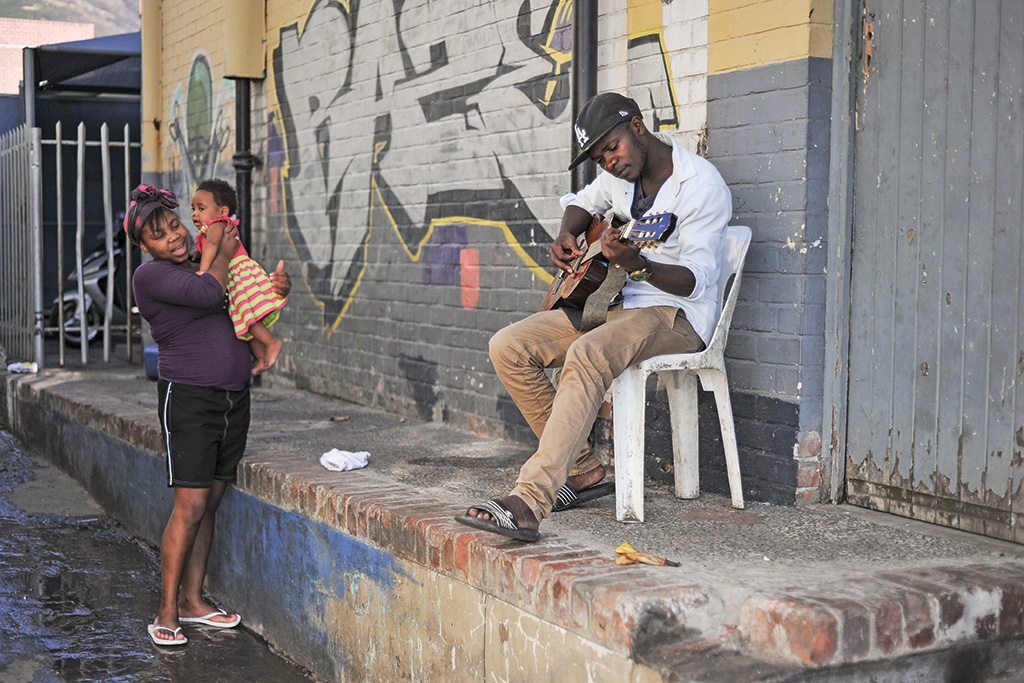
Tunes from as far afield as Malawi and Gabon can be heard in Woodstock.
They’re missing out. If they walk the streets there is wonder to be found, not just among the people but the art, too. The area has become a massive canvas for local and international artists. Some paintings are related to the ‘I Art Woodstock’ project, a collaboration between /A WORD OF ART and adidas. Each year since 2017, Baz-Art runs the International Public Art Festival which commissions artists from all over the world to adorn the walls of private homes, public spaces, schools and factories. Working to a prescribed theme, artists are inspired to produce work that promotes inclusivity, dialogue, collaboration and positivity.

Quiet Sunday streets make for great sporting events outside Nurul Islam Mosque.
On one of my walks to view the art, I meet Salt River resident Nigel and his sons Jonah and Felix. It’s not long before the sun slides behind Table Mountain, and I’m heading to one of my favourite murals on the edge of Shelly Street Sports Field. As I approach, a flock of pigeons scatters. I see one of the boys cupping something in his hand, a young pigeon they rehabilitated after finding it abandoned. They’d named it Sky Rat and here they are trying to reintroduce it to its own kind. They hoist it up encouragingly. Each time it spreads its wings and gains air, then turns and flutters back towards the boys. Why leave a good home?
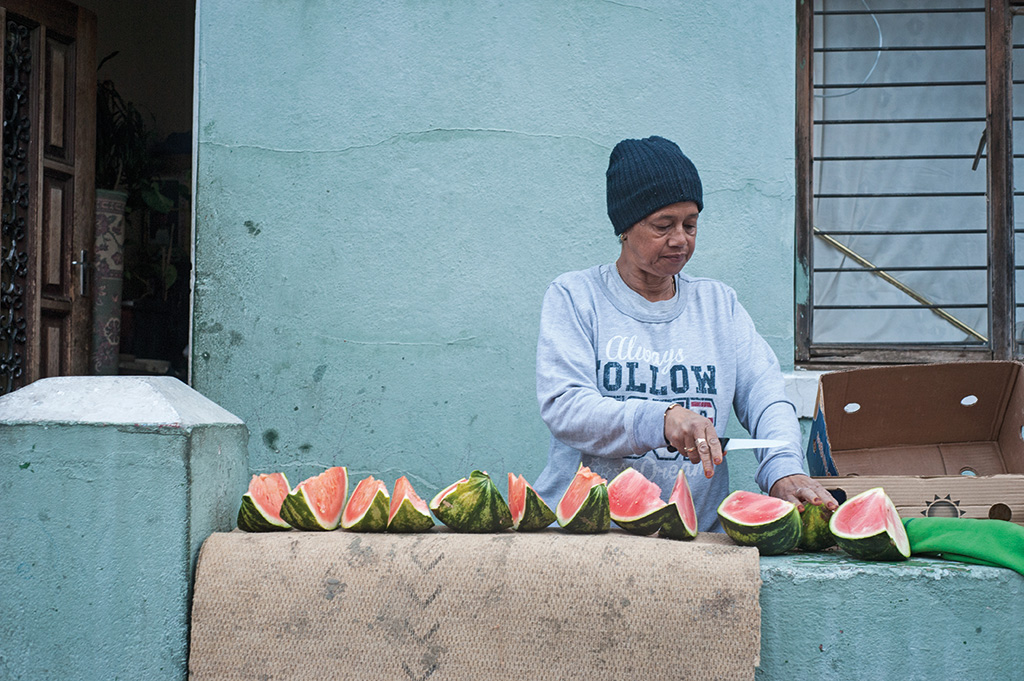
Allaweiya slices up watermelons for the neighbourhood kids on hot Friday afternoons.
I chat with the boys and their dad for a while. Like most locals they’re charming and open. There’s Ahmed who owns a corner café nearby, who’s shy until you greet him and his stories come alive, or like David, the administrator of Sulaimania Masjied, who hails me like an old friend and invites me to dinner only the second time I met him. Like Allawieyah who slices watermelons on her porch for neighbourhood kids to feast on, or like Sara whose impromptu house party I attend. I urge you, take a walk in these streets, on your own or with a guide. Say ‘as-salamu alaykum’, ‘bonjour’, ‘yenge kiaku,’ ‘muli bwanji,’ ‘mhoro’ or ‘hoezit’ to the people of Salt River and Woodstock. It’s as fine a home as any.
Local Characters
Nel has her mother’s name, Jolene, tattooed on her left shoulder. On her right the names of her children – Natheer, Tasneem and Mishka – are inked for prosperity. They are rough blue lines that bleed into her skin, a bit like street art that colours these walls and tell a deeper story.
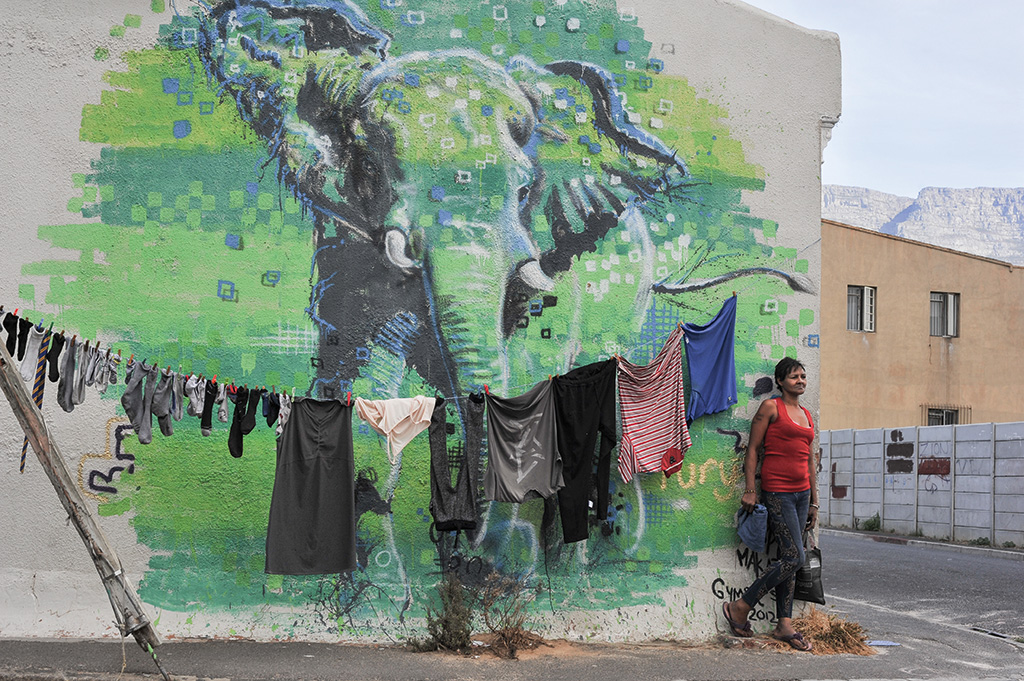
Born in District Six, Daniel is old enough to remember the bulldozers tearing up his home and his family fleeing to Woodstock where he has lived ever since, bar the 14 years he spent in prison ‘for gang related stuff’, he says.
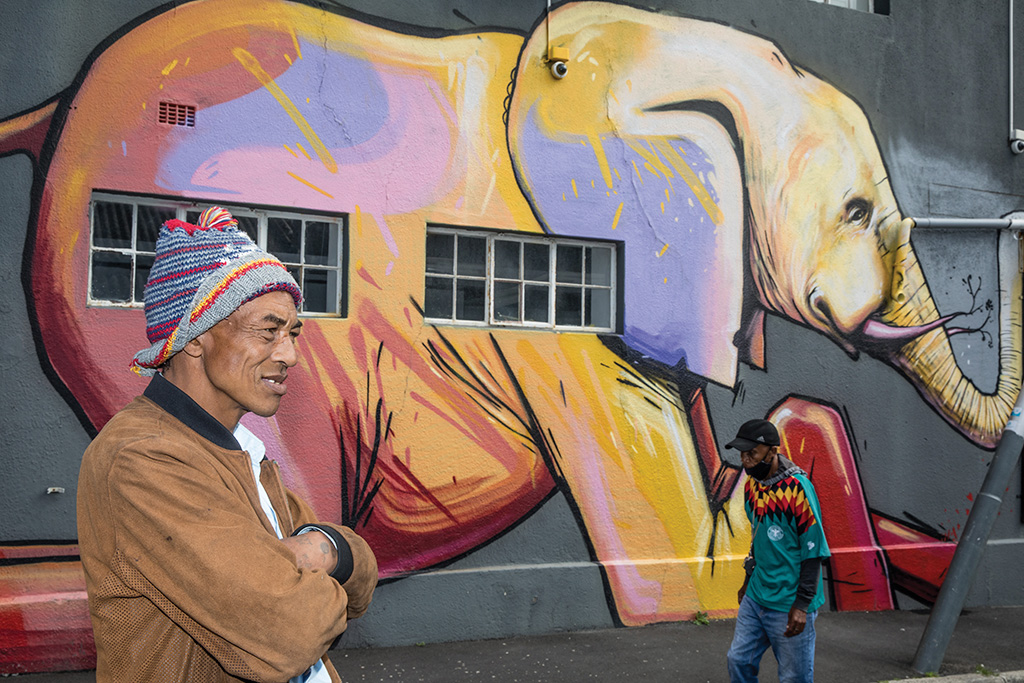
Do This
Find out more about Baz-Art and the International Public Art Festival:baz-art.co.za
Book a street art tour with a local tour guide
Tours can be booked 24 hours in advance. Minimum two people. 2 hr tour R650 pp (kids under 12 free)
baz-art.co.za [email protected] 079 03 18 943
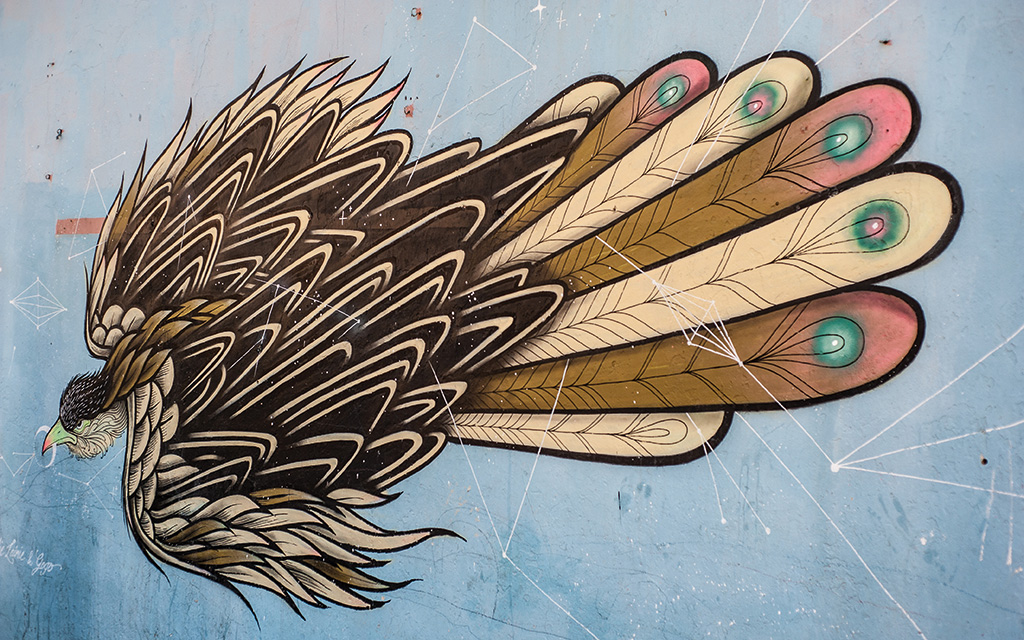
Perhaps because they are a symbol of freedom, birds appear to be the most common artistic theme in Woodstock.
Download audio guides to your phone
Take an audio tour with local voices, stories and maps from Voice Map – a great way to explore this community in your own time: voicemap.me
Baz’Art Salt River Street Art Tour: R99
A Community in Crisis: Gentrification in Woodstock & Salt River: R32
Starting up in Woodstock: Free

